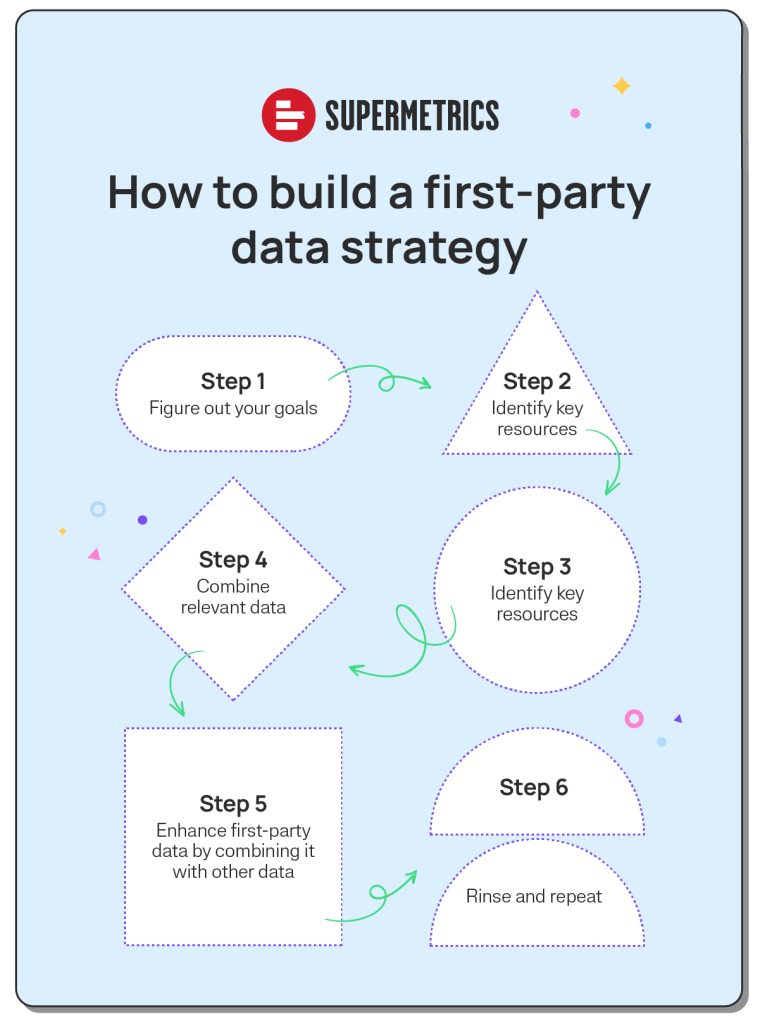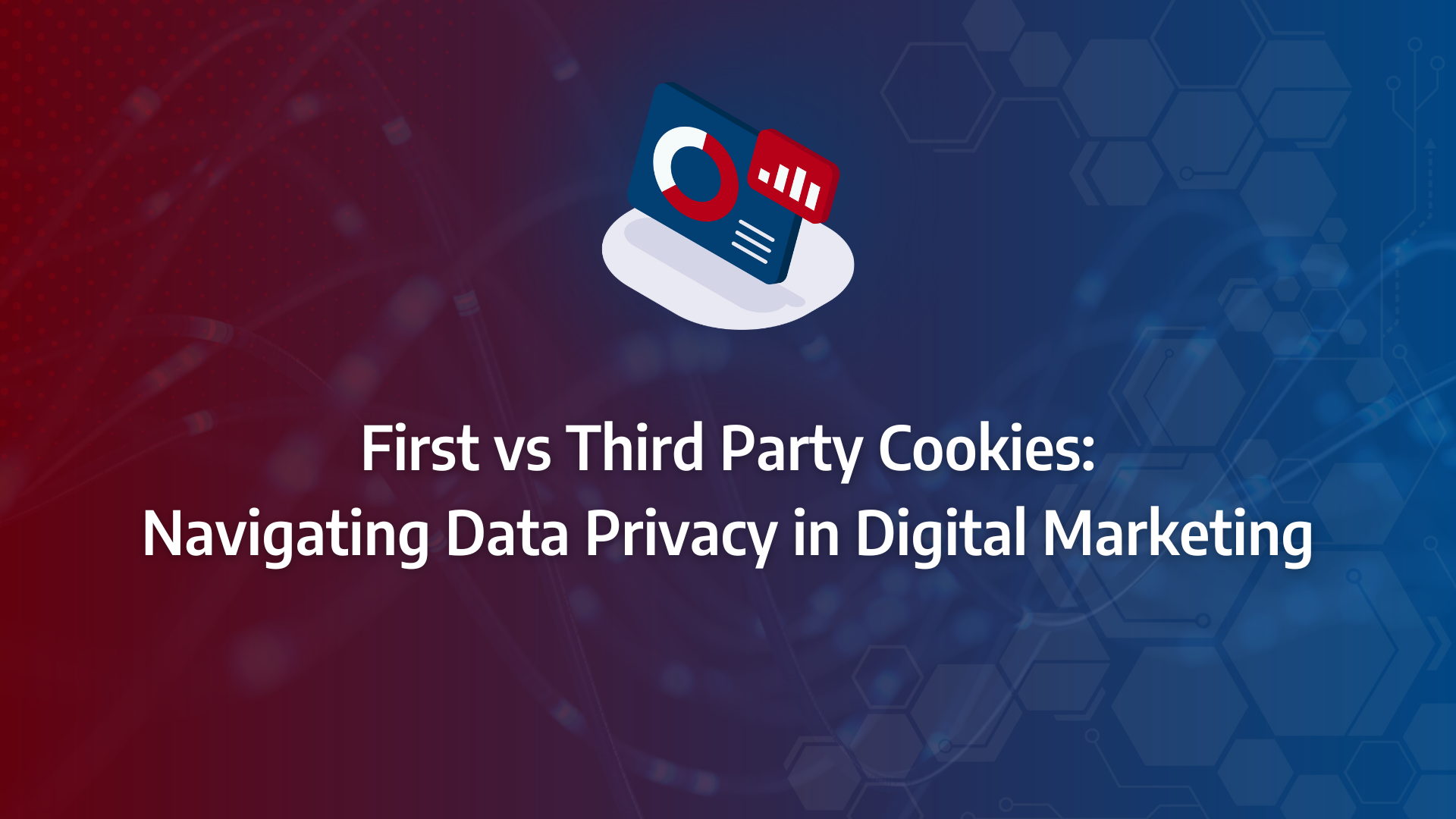With major browsers phasing out third-party cookies, businesses face a critical challenge: how to maintain effective digital marketing strategies while respecting user privacy. Understanding the key differences between first-party and third-party cookies is more important than ever.
These small pieces of data play a huge role in tracking user behaviour, targeting ads, and personalising content—but not all cookies are created equal. As privacy concerns grow, businesses must shift their focus towards first-party data to stay ahead. In this guide, you’ll discover how to navigate this transition, adopt new tools and strategies, and ensure your marketing efforts remain both compliant and effective.
- Understand the Difference: First-party cookies are stored by the website a user visits, while third-party cookies are stored by external domains, making them a focal point of data privacy concerns.
- Embrace First-Party Data: As third-party cookies are phased out, businesses must pivot to leveraging first-party data to maintain personalised marketing strategies and comply with privacy regulations.
- Implement New Strategies: Transitioning to a first-party data strategy involves investing in customer data platforms (CDPs) and enhancing transparency with users to build trust.
- Utilise Privacy Tools: Use tools and technologies designed to manage cookies and user data effectively, ensuring compliance with GDPR and other data privacy laws.
- Prepare for the Future: Stay ahead by understanding the potential replacements for third-party cookies and adapting your digital marketing strategies accordingly.
What do I need to know about first-party cookies and their uses?
Understanding First-Party Cookies
First-party cookies, often referred to as HTTP cookies, are small data packets generated by your web browser and exchanged with the server of the website you are visiting. These cookies are unique to the domain that created them, hence the designation “first-party”. Their primary function is to enhance the user’s browsing experience by recognising returning visitors, applying their preferred settings, and facilitating easier log-ins. Website operators rely on this cookie-based data to gain valuable insights into visitors’ browsing behaviour and interests, which can be instrumental in shaping effective strategies in cookies in digital marketing. While some cookies are designed to expire at the end of a browsing session—known as session cookies—others can persist for extended periods.
One of the defining features of first-party cookies is their limited accessibility; only the website that created them can generate and view the data stored within these cookies. This stands in contrast to third-party cookies, which are created by external domains and often used in advertising. The distinction between first-party vs third-party cookies is crucial, particularly in discussions surrounding user privacy and data management.
How First-Party Cookies Operate
Upon your first visit to a website, you may encounter a banner alerting you to the site’s use of cookies. This banner typically requests your consent to proceed. Once you click “Accept,” a first-party cookie is generated, storing your consent. This action ensures that the consent banner does not reappear on subsequent visits.
Moreover, these cookies may store other user preferences, such as your chosen language or your log-in email address—though not your password—thereby streamlining future interactions with the site. For websites with vast content archives, first-party cookies might also enable features like a sidebar linking to your recently visited subpages, enhancing the overall user experience by making navigation more intuitive.
These functionalities demonstrate the integral role of first-party cookies in both user experience optimisation and in providing website operators with key insights into user behaviour. This data, collected through first-party cookies, is pivotal for refining and personalising marketing strategies, particularly within the context of cookies in digital marketing.

GDPR and First-Party Cookies
The General Data Protection Regulation (GDPR) mandates that websites obtain explicit consent from users before collecting and processing their personal data, which includes the use of both first-party and third-party cookies. Compliance with GDPR requires websites to present clear, straightforward information about their cookie usage and to secure affirmative user consent—typically through a clickable “I accept” button. Furthermore, GDPR stipulates that users must be provided with the option to withdraw their consent at any time, underscoring the importance of user control in data privacy.
This regulatory framework significantly influences how first-party vs third-party cookies are implemented and managed, particularly in Europe where GDPR enforcement is stringent. Ensuring compliance not only protects user privacy but also fosters trust, which is essential in today’s digital landscape.
What Matters Most?
From our experience, the transition from third-party to first-party data isn’t just a compliance exercise; it’s a strategic pivot that can redefine customer relationships. Companies that typically embed privacy by design into their data practices often find themselves not only meeting regulatory requirements but also building deeper trust with their customers. Clients often discover that by investing in a first-party data ecosystem, they unlock richer insights and more personalised experiences that drive better business outcomes.Get In Touch
What Are Third-Party Cookies?
Understanding Third-Party Cookies
Third-party cookies are distinct from first-party cookies in that they are created by a domain other than the one you are currently visiting. For example, if your website includes a “Like” button from Facebook, a cookie may be stored on the visitor’s computer by Facebook, not your site. This cookie is subsequently accessed by Facebook to identify the visitor and track their activity across multiple websites. Such cookies are integral to third-party data tracking and are a foundational element in cookies in digital marketing.
A more widespread example is seen with advertising services like Google Ads. These services generate third-party cookies to monitor user activity across different sites. This tracking mechanism is what enables the persistent ads that follow you across the web, showcasing products you may have previously searched for on entirely unrelated websites. The ability of third-party cookies to facilitate this kind of targeted advertising is what makes them so valuable in the digital marketing landscape.
How Third-Party Cookies Work
Imagine a scenario where, earlier in the week, you were researching vacation rentals in Cancun. You visited several websites, enjoyed looking at the beautiful beach photos, but ultimately decided to postpone your holiday plans. A few days later, you notice that ads for Cancun vacations have started appearing on numerous websites you visit. This occurrence is far from coincidental. What’s happening here is that your web browser stored a third-party cookie from one of those travel sites. That cookie is now being used to serve you targeted advertisements based on your previous searches.
Many web users are unaware that multiple open tabs in a browser still constitute a single browsing session. As you move from tab to tab, third-party cookies are actively collecting and sharing information about your web activity with other domains. It’s important to note that merely closing your browser does not necessarily delete these cookies; your browser settings may require you to manually remove them.
The Decline of Third-Party Cookies
The era of third-party cookies is rapidly coming to an end, primarily driven by new regulations such as the CCPA, ePR, and GDPR, which aim to bolster user privacy. These laws mandate that websites inform users about the presence of cookies and detail what data is being collected and how it will be used. Additionally, they require websites to offer users the option to opt out of data collection at any time.
This regulatory environment, coupled with growing consumer demand for privacy, has led many tech companies to phase out third-party cookies. For instance, Apple’s Safari and Mozilla’s Firefox browsers now block third-party cookies by default. Google Chrome, despite commanding 67% of the browser market share, has delayed similar actions due to the substantial portion of its revenue—nearly 90%—derived from advertising. However, Google has committed to limiting the more intrusive features of third-party cookies through tools like SameSite, with plans to fully block them in the near future.
Source: BCG & LinkedIn
How do third-party cookies differ from first-party cookies in practice?
Understanding the nuances between first-party cookies and third-party cookies is essential in cookies in digital marketing, as each type serves different purposes and comes with its own set of implications.
Ownership and Data Collection:
- First-Party Cookies: These are set by the web server of the publisher and are used exclusively by the website owner. The data collected remains within the confines of the site, providing insights into user behaviour specific to that domain.
- Third-Party Cookies: In contrast, third-party cookies are created by external servers via code embedded on the publisher’s website. The data collected is processed by these third parties, often for broader purposes such as cross-site tracking and targeted advertising.
Cookie Availability:
- First-Party Cookies: These cookies are accessible only by the domain that created them, ensuring that the data remains within the intended website.
- Third-Party Cookies: These are accessible across any website that loads the third-party server’s code, allowing data to be shared across multiple sites, which is both a benefit and a drawback depending on the context.

Enabling or Blocking Cookies:
- First-Party Cookies: Supported by default across all browsers, first-party cookies can be blocked or deleted manually by the user, giving them more control over their data.
- Third-Party Cookies: Many browsers now block third-party cookies by default due to increasing privacy concerns. However, users can still choose to delete or block them independently if they wish to do so.
Regulation and Cookie Consent:
- Third-Party Cookies: The use of third-party cookies is heavily regulated by privacy laws such as GDPR and CCPA, which require explicit user consent. Websites must inform users about the presence of these cookies and allow them to opt out if desired.
- First-Party Cookies: Often considered essential for basic website functionality, first-party cookies generally do not require explicit consent under most cookie laws. However, websites are still obligated to inform users about their use and the purpose behind them, ensuring transparency.
Our Tactical Recommendations
We’ve found that starting with a thorough audit of your data practices is essential for a seamless transition from third-party to first-party data. Clients typically uncover critical dependencies and vulnerabilities that need addressing. Implementing privacy-enhancing technologies alongside user-centric tools empowers customers to manage their data preferences, fostering trust and compliance. From our experience, integrating CRM systems with marketing platforms allows businesses to deliver personalised experiences that boost engagement and conversions across every touchpoint, driving tangible results in a cookieless future.Get In Touch
What are the best practices for managing cookie consent on my website?
Key Considerations When Using Internet Cookies
The use of cookies in digital marketing is a powerful tool for targeting consumers and enhancing user experience. However, mismanaging cookie consent and handling personal data improperly can severely damage your business’s reputation and invite legal repercussions. To navigate this complex landscape, it is essential to adhere to best practices when implementing cookie technology on your website.
Classify Your Cookies: To maintain clarity and compliance, it’s crucial to classify each type of cookie used on your site. This includes distinguishing between HTTP cookies, web beacons, JavaScripts, and Flash LSOs. Assigning unique domain names for each technology helps differentiate between standard site functionality and more advanced behavioural advertising practices. This approach ensures that your use of cookie-based data aligns with user expectations and legal requirements.
Opt-Out Policy: A transparent and easily accessible opt-out policy is fundamental. Ensure that all opt-out mechanisms are consistent, particularly in terms of cookie naming conventions. For example, the opt-out cookie for the Digital Advertising Alliance (DAA) should match the Network Advertising Initiative (NAI) opt-out cookie name. Additionally, these cookies should have a minimum expiration period of five years to respect and maintain user preferences. Regularly testing opt-out functionalities is also critical to ensure they work as intended and provide a seamless user experience.
Data Retention Policies: Effective data retention policies are vital for both compliance and user trust. Retain cookie-based data only for as long as it is necessary for business operations or as legally required. Where possible, favour session cookies over persistent cookies, giving users the option to accept persistent cookies for functions such as logins. Set expiration dates for persistent cookies that reflect the relevance and usefulness of the data, ensuring that outdated or unnecessary information is not retained longer than necessary.
Audit and Review: Regularly auditing your website’s cookie usage is a best practice that cannot be overlooked. This includes assessing not only your own site’s cookies but also those used by third parties. Ensure that all cookie usage aligns with your privacy policy and the privacy policies of any third-party services you employ. It is also important to verify that third parties have the appropriate authorisation to set cookies on your site. Understanding the purpose of these third-party cookies and ensuring they do not conflict with your stated privacy practices is essential to maintaining user trust and compliance.
Compliance with Cookie Consent Requirements: Compliance with cookie consent regulations such as GDPR, CCPA, and CPRA is non-negotiable. Website owners must display a clear and conspicuous cookie consent notice on their homepage. This notice should inform users of the cookies in use and obtain explicit consent before setting any non-essential cookies. Users must also have control over their cookie preferences, typically through a widget or similar tool that allows them to opt in or out of specific types of cookies.

Third-party plugins, including those from social media platforms like Facebook, are also subject to these consent requirements and must be explicitly mentioned in your consent notice. It is imperative that no personal data, such as unique identifiers, is collected without user consent. Non-compliance with these regulations can lead to substantial fines and significant damage to your business’s reputation. By prioritising best practices for cookie compliance and maintaining transparency, website owners can protect user privacy and adhere to GDPR and other relevant laws.
Implementing Cookie Consent Banners
One of the most effective methods for obtaining user consent for cookies is through the use of cookie consent banners. These banners typically appear as a pop-up or header on the website, clearly informing users about cookie usage and requesting their consent.
Clarity and Conciseness: Your consent banners should be designed for clarity and ease of understanding. They must succinctly explain the types of cookies in use and their purposes. For example, a banner might explain that the website uses analytics cookies to monitor user behaviour and advertising cookies to deliver targeted advertisements. The information should be straightforward, avoiding unnecessary jargon, so users can quickly comprehend what they are consenting to.
Opt-In Mechanism: In the European Union, GDPR mandates that consent for cookies must be obtained through an opt-in mechanism. This often involves a checkbox or button that users must actively click to give their consent. Additionally, the banner should provide users with options to customise their cookie preferences or opt out of certain categories entirely. This level of control is critical in ensuring that consent is informed and compliant with GDPR standards.
What challenges will arise in digital marketing without third-party cookies?
As we transition into a cookieless future, brands, publishers, and consumers alike are poised to encounter a series of significant challenges that will reshape the landscape of digital marketing.
Loss of Audience Targeting
The elimination of cross-website user tracking represents a formidable obstacle for traditional retargeting and prospecting methods. Historically, third party cookies have been instrumental in gathering cookie based data on users’ browsing habits, which has allowed advertisers to craft highly tailored advertising strategies. In the absence of this data, the ability to reach target audiences with precision is considerably diminished. For brands heavily reliant on cookies in digital marketing, this shift demands the exploration of alternative strategies to maintain effective audience engagement.
Source: BCG & Linkedin
Difficulty Measuring Ad Performance
The challenge of accurately measuring ad performance is set to intensify without the insights provided by third party cookies. Advertisers have long depended on these cookies to track a variety of user activities, from referral sources to cross-channel interactions. The absence of detailed, cookie-based data complicates the process of evaluating campaign effectiveness, making it harder to obtain a comprehensive understanding of user journeys and audience engagement. This lack of clarity can hinder the optimisation of digital marketing efforts, requiring new methods to assess performance.
Reduced Ad Personalisation
The decline of third party cookies poses a direct threat to the personalisation of advertising and content delivery. Personalised ads, which have proven highly effective in capturing user attention and driving conversions, rely heavily on data derived from cookies. In a cookieless environment, advertisers will struggle to deliver tailored messaging to specific audiences, resulting in more generic, less engaging campaigns. The challenge for marketers will be to find innovative ways to maintain the relevance and impact of their advertising efforts without the granular insights previously provided by cookie-based data.
Disjointed User Experience
Cookies play a crucial role in personalising the online experience by remembering user preferences, login details, and shopping cart contents across websites. The removal of cookies threatens to disrupt this seamless experience, leading to a more generic and potentially frustrating browsing experience for users. Without the ability to store and recall these details, websites may become less intuitive, and users might find themselves repeatedly entering information that was once effortlessly remembered. This shift could result in a less engaging and more fragmented user experience, which may ultimately impact user satisfaction and loyalty.







